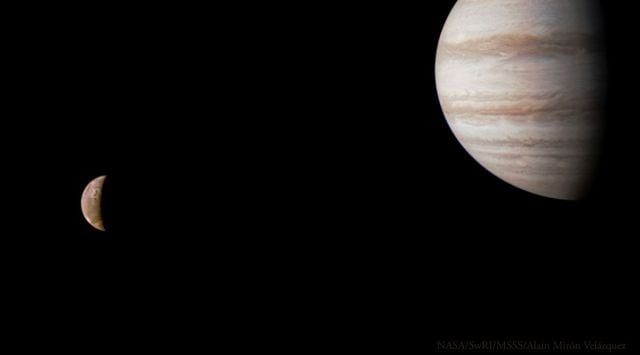NASA’s Juno spacecraft captures spectacular portrait of Jupiter and its moon Io
NASA's Juno mission took this image of Jupiter and the most volcanic world on the solar system just hours before a close flyby of the gas giant.
 Jupiter and its volcanic moon Io can be seen in this image . (NASA/JPL-Caltech/SwRI/MSSS/Alain Mirón Velázquez)
Jupiter and its volcanic moon Io can be seen in this image . (NASA/JPL-Caltech/SwRI/MSSS/Alain Mirón Velázquez) The National Aeronautics and Space Administration’s (NASA) Juno mission completed its 53rd close flyby of Jupiter on July 31 this year and just hours before that, it sped past the gas giant’s volcanic Moon Io and captured this stunning frame of both of them together.
Io is the most volcanically active world in our solar system and it has hundreds of volcanoes that often erupt with molten lava and sulphurous gases. The Juno mission has given scientists the closest look at Io since 2007 and it will continue to gather images and science data during even close flybys later this year and early in 2024.
Io is slightly larger than the Earth’s Moon and has a diameter that is about one-quarter that of our planet. Io is tidally locked to Jupiter, meaning that one side of the Moon always faces the planet. It takes around 1.8 Earth days to both rotate on its axis and revolve once around Jupiter.
It has a very thin atmosphere that is primarily made of sulphur dioxide but one of the most interesting features of the Jovian moons is its volcanoes. The most volcanically active world in the solar system has hundreds of volcanoes with some erupting fountains of lava that are dozens of kilometres high. It even has lakes of molten silicon lava on its surface.
The volcanic moon was also represented in the movie ‘2001: A Space Odyssey’, where astronauts were shown conducting a dangerous spacewalk above its volcanoes to board an abandoned spacecraft.
To make this image, citizen scientist Alain Mirón Velázquez worked on a raw image from the JunoCam instrument on the mission to enhance its contrast, colour and sharpness. At the time the raw image was taken the Juno mission was about 51,770 kilometres from Io and about 395,000 kilometres from Jupiter’s cloud tops.







